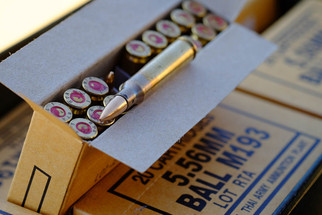Posted by Modulus Arms on 22nd Apr 2022
M193 Explained
M193: The Grandfather of 5.56mm Ammunition
Beginning in the mid to late 1950s it was decided that the American Warfighter needed a rifle and cartridge that was lighter, would sustain accurate fire over mid-ranges, and would allow much more ammunition to be carried into the conflicts. With all this in mind Eugene Stoner’s Armalite created the AR type rifles later known as the M-16. With these rifles came an extremely fast and accurate cartridge with a 5.56-millimeter diameter, allowing a smaller powder charge than the 7.62x51 or the 30-06 to push its bullet downrange at a blistering 3,250fps. A small projectile traveling at that speed would become unstable upon impact and tumble through the target meeting all the requirements of a manageable firearm with deadly impact, just what Uncle Sam was looking for.
Created for the Vietnam era M-16A1, the M193 was and still is a well performing round. Though in the jungle it was found to have some slight flaws that would not have been otherwise known outside of such a conflict. We will discuss what makes the M193 great and what some of those minor flaws were.
M193 Characteristics
First off, let’s talk about flight and what M193 Ballistics look like. We all know a heavy and slow projectile packs a punch on impact, but what make an extremely fast and small bullet so effective? The ballistics of M193 are slightly insane and genius at the same time.
When you have a projectile that only weighs 55 grains being propelled by 25 to 25.8 grains of powder (depending on the manufacturer of the powder) you are going to get a rocket. Now cap off that speed with a bullet that is a bit off balance on impact, heavy in the rear and light in the front, you get a tumble that is extremely effective on soft targets.
When using a M-16 style rifle with a 20-inch barrel the M193 has stellar performance on point targets out to 500 meters. This means you can hit what you’re aiming at out to 500 meters with desired effects. If you are the type of person that likes to lay down covering fire, well the M193 will absolutely whiz by an area target out to 800 meters. Not bad for a small round that doesn’t carry as much energy as your heavier calibers.
What Can You Expect from M193 Ballistics?
When talking about Internal Ballistics we are looking at how well the projectile performs within the confines of the barrel all the way to the muzzle and how that affects the bullet’s flight.
For the sake of most modern rifle owners, we’ll stick with modern AR-15/M-16 twist rates. Typically, modern AR-15’s are rifled with a twist rate of 1:9 and M-16’s are cut with 1:7 twist, this means you get a full rotation of the bullet every 9 or 7 inches. This is great for stabilization of your projectile for a straighter and more consistent flight path.
The M193 is at the light end of the 5.56 spectrum coming in at 55 grains. It is zipping through those rifling’s and coming out the other end with a tight spiral that would outclass even the best and highest paid quarterbacks. Out to around 300 meters you are looking at a nice tight group that is relatively unaffected by external factors such as wind. We’re going to touch on that next.
M193 Terminal Ballistics
Light and fast make for great accuracy at mid-ranges 100 to 300 meters with little thought to windage, elevation, humidity... you get the point. Once you push your shots out beyond the 300 meter mark the M193 ballistics require a little more thought to point of aim – point of impact.
As you go out farther, the M193 begins to lose velocity and energy rapidly. Just like throwing a ball, when it slows down at the receiving end it starts to drop so you must throw in an arc to get it where you want it. Making a long range shot with a lightweight bullet your sights will need to exaggerate the arc substantially while also accounting for drift.
Unlike the M855 Green Tip most of us know and love, the M193 has a lead core rather than the steel core penetrator. Without that steel core the M193 does not fare as well when it comes to harder target pass-through. A copper jacket over a lead core typically flattens and disintegrates causing fragments to enter and rip through the target, this is effective in combat and great for steel target shooting. However great that might be it is not necessarily great for all aspects of combat use like thick forests or doors and windows of urban conflicts.
Up close and out to the 300-meter range we spoke of earlier the M193 is extremely effective at leaving as much energy and fragmentation as possible at the target.
Why Continue the Manufacture of M193 Ammo?
It is clear that 5.56mm ammunition has come a long way since the days that M193 was the king of the jungle, however short that reign may have been. BUT what is down may not necessarily be out. M193 is still an outstanding performing round.
M193 has great ballistics when looking at accuracy out to 300-meters and is perfect for training on steel targets. It is never a good idea to use M855 Green Tip ammo on steel because you can damage your targets rather quickly and that steel core is not something you want to ricochet back toward the firing line.
The 55-grain lead core is often times cheaper to buy in bulk and has been mass produced since the first days of the AR rifles coming off the assembly line, so it is likely easier to find in times of great ammo depressions.
If you are a stone-cold AR guy you’ve likely come across these rounds one or ten thousand times in your life, and you know they are accurate and reliable. If you feed them through a well-built rifle, you can stack holes on top of holes with no problem.
What is the ballistic coefficient of M193?
Assuming perfect conditions, the Ballistic Coefficient for M193 55gr ammunition, at sea level (G1 force) with zero wind is around 0.371.
What is a ballistic coefficient?
A Ballistic Coefficient is the projectiles’ ability to overcome air resistance while in flight. There are many factors to consider such as elevation pressures and wind direction/speed. If you absolutely need to know the ballistic coefficient for your cartridge, there are many sites where you can download a Ballistic Coefficient Calculator such as ShootersCalculator.com.
What is terminal ballistics?
Terminal Ballistics refer to the bullet's condition and transfer of energy on impact. I.E., the way a hollow point opens and the wound cavity created or how a FMJ impacts, fragments, dumps energy and creates wounds when impacting a target. Terminal meaning the end is literally the end of a bullet’s flight.
Is M193 good for home defense?
Rifle cartridges in general are not ideal for home defense due to their over penetrating power. Considering most homes are plywood and sheetrock, you do not want to send rounds through the neighborhood. The M193 is a Full Metal Jacket (FMJ), which is known to pass through construction materials easily. Remember, you are legally and morally responsible for every shot you fire.
Shoot M193 out of a Modulus Arms Build
Looking for a rifle that can withstand the thousands of M193 rounds you’ve just purchased? Check out our full line of 80% Lowers at Modulus Arms and get some while they’re HOT!

